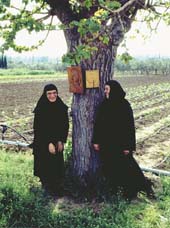|
|
|
|
 |
|
The Seven-Year Plan: Theology, wisdom and guidance
Link
here to download the latest guidelines to the full Seven Year Plan. (Note this is a 2MB document).
a. Traditions of Simple Living:
*** Can you draw upon any of your own traditions - monasticism for example - to develop and promote a simpler lifestyle?
b. Training:
*** How do you train your religious teachers and future religious leaders on environmental issues? Could the training curriculum for your future priests, imams, rabbis etc be ‘greened’?
c: Crisis and Adaptation:
*** What is the role of crisis in your theology and how have you dealt with crises in the past?
*** Does your faith see climate change as a crisis today? If so, what strategies or tools from your experience could you apply to responding to climate change?
d: Liturgies, quotations and prayers:
 |
 |
 |
Can you draw upon any of your own traditions - monasticism for example - to develop and promote a simpler lifestyle? The picture shows Orthodox nuns at Solan monastery in France, who live simply, and have followed organic farming and forestry methods for many years. |
*** Can your liturgies, services, or orders of prayer and practice, be developed in line with your theology to include not only your tradition of caring for the natural world but your values of treading lightly on the earth, and judging people by how they behave, not by what they own?
e. Sacred places:
*** What role have your sacred places traditionally played in helping preserve habitats for wildlife? For example, churchyards are often vital mini-eco-systems especially in urban areas; sacred mountains are sanctuaries for many endangered animals; holy water sources – wells, streams and lakes – can be the last refuge for creatures whose habitats have otherwise been destroyed or polluted.
f. Stories and Practices:
Are there any stories or half-forgotten traditional practices that highlight how your tradition has always cared for creation/the natural environment, and can these be revived?
g. Adaptation:
Have you thought about how your teachers and faith leaders will care in a pastoral way for those affected by climate change?
Have you created a plan to do so, so that in case of flood, or famine or typhoon, you are as prepared as you can be?
SOME IDEAS AND EXAMPLES
* Re Simple Living: Jain youth organisations have long encouraged their members to advocate simple, non-meat diets. They believe this would not only reduce the negative karmic effects caused by the suffering resulting from killing animals on such a large scale, but would also improve the earth ecologically, by reducing the grain needed to fatten livestock and the greenhouse gases emitted by cattle in particular that are fed unnaturally on grain.
* Re Crisis and Adaptation: The Benedictine Order of Catholic monks and nuns have rediscovered that their Order helped pull most of Europe out of the ecological collapse caused by the Roman Empire which, by the 6th century AD, had destroyed much of the forestry and farm land of the Empire. The Benedictines replanted forests, recreated watersheds, dug streams and ponds and reintroduced composting for the land. Perhaps this strategy can help us out of this crisis too. Link here for details of the Benedictine Handbook, Listening to the Earth - published, as a collaboration with ARC and the World Bank, in Portuguese, Spanish and English.
* Re Sacred Places: The sacred mountains of China have been protected for millennia by Daoist nuns and monks. Now Daoism is actively developing environmental protection programmes to ensure that the pressures of tourism, development and forestry do not endanger these vital places of spirituality, ecology and culture.
* Re Liturgies: The Orthodox Churches have recently developed special new liturgies to celebrate their Feast of Creation on September 1st. These new prayers and hymns reinforce the special role Orthodox Christianity gives to not just protecting creation but blessing it and making it even more wonderful.
* Re Stories and Practices: Zoroastrians in India have remembered their traditional story of how, once upon a time, Mother Earth was in trouble. She asked God – Ahura Mazda – if He could send her a prince, with warriors, to stop the people from hurting her, using force. But Ahura Mazda said he could not. Instead he would send Her a holy man, to stop the people from hurting her, using words and inspirational ideas. And thus was born the prophet, Zoroaster. Also, the Zoroastrians used to have a tradition of building houses with reservoirs under them into which all rain water was directed in order to ensure the best use of water, and keep homes cool. Perhaps some cutting edge Zoroastrian architects can work out how to start building like that again.
* Re: Stories and Traditions: In Mongolia the Buddhists worked with ARC, WWF and the World Bank to rediscover ancient sutras, or texts, that had been lost or hidden during the Soviet/Communist period. These texts told people about the sacredness of the landscape around them - and prescribed which mountains and forests were particularly sacred and should not be logged or hunted "lest the goddess flood your village." By retranslating this old wisdom, ancient ecological knowledge has been preserved and acted upon. Link here for more details.
LINKS
Link here for the main project page to explain the Seven Year Programme.
Link to the
Latest Guidelines for the Seven Year Plan (this is a 2MB document).
Link to the Frequently Asked Questions
page.
The Other Six Key Areas are:
1. Faith-consistent use of Assets: land, investments, purchasing and property
2. Education and Young People
4. Lifestyles
5. Media and Advocacy
6. Partnerships and Creating your own Environment Department
7. Celebration
|
 |
|
|
|
|
|
 |
ARC Newsletters
Newsletters sent out by ARC |
 |
Inspiration
Inspiring ideas and stories about protecting the planet through faith and community |
 |
 |
|
|

